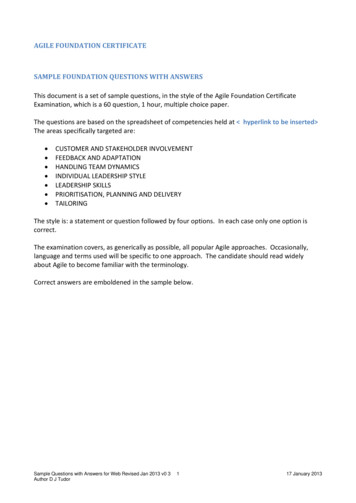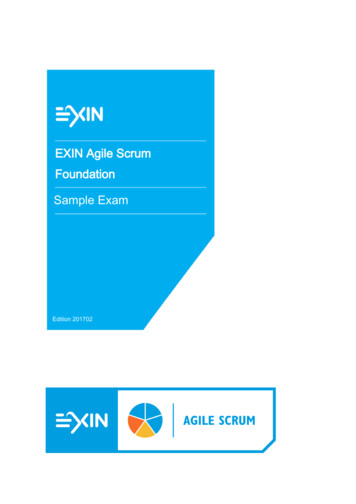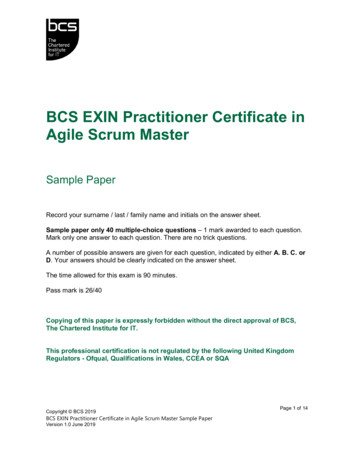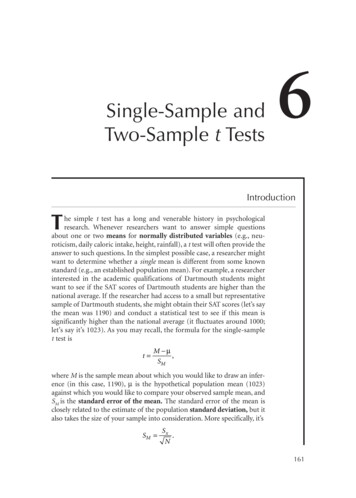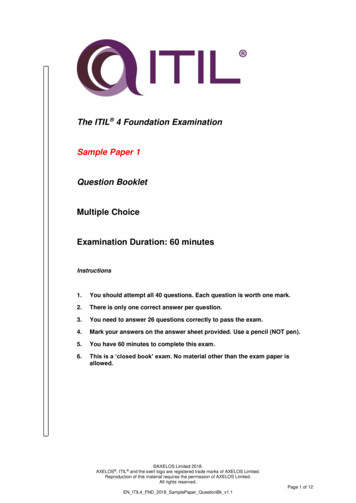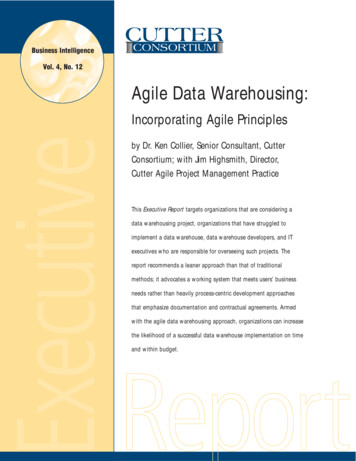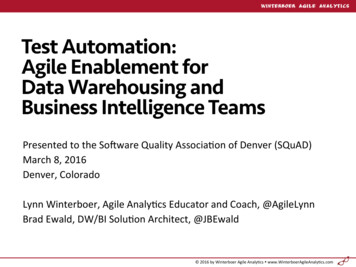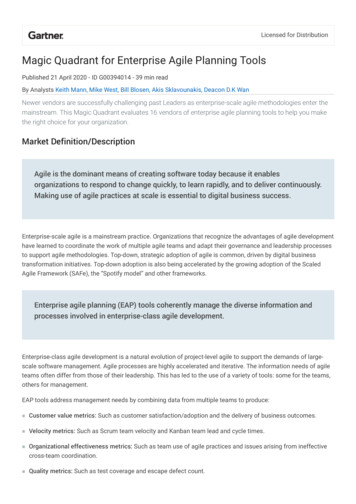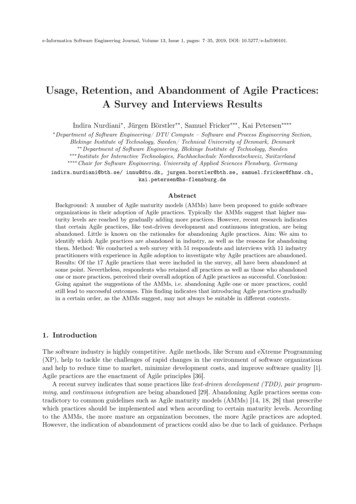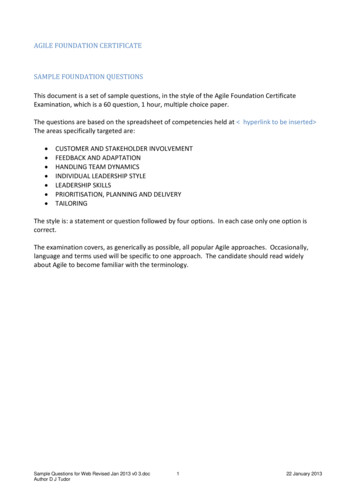
Transcription
AGILE FOUNDATION CERTIFICATESAMPLE FOUNDATION QUESTIONSThis document is a set of sample questions, in the style of the Agile Foundation CertificateExamination, which is a 60 question, 1 hour, multiple choice paper.The questions are based on the spreadsheet of competencies held at hyperlink to be inserted The areas specifically targeted are: CUSTOMER AND STAKEHOLDER INVOLVEMENTFEEDBACK AND ADAPTATIONHANDLING TEAM DYNAMICSINDIVIDUAL LEADERSHIP STYLELEADERSHIP SKILLSPRIORITISATION, PLANNING AND DELIVERYTAILORINGThe style is: a statement or question followed by four options. In each case only one option iscorrect.The examination covers, as generically as possible, all popular Agile approaches. Occasionally,language and terms used will be specific to one approach. The candidate should read widelyabout Agile to become familiar with the terminology.Sample Questions for Web Revised Jan 2013 v0 3.docAuthor D J Tudor122 January 2013
Sample Agile Foundation Examination Questions:1. Which of the following best describes the approach for determining the iteration (timebox)length?A.B.C.D.Iterations (timeboxes) should always be 30 daysThe team determines iteration (timebox) length by dividing the total number of storypoints by the average velocity of the teamIterations (timeboxes) should always be two weeksThe team should agree on the length of the iteration (timebox), taking the size andcomplexity of the project into consideration2. Which of the following is a characteristic of an Agile leader?A.B.C.D.Task focusedProcess orientedSupportiveDisengaged3. Who is responsible for prioritizing the product backlog?A.B.C.D.Product OwnerProject ManagerLead DeveloperBusiness Analyst4. What are the advantages of maintaining consistent iteration (timebox) length throughout theproject?A.B.C.D.It helps to establish a consistent pattern of deliveryIt helps the team to objectively measure progressIt providea a consistent means of measuring team velocityAll of the above5. Tracking project issues in an Agile project is the primary responsibility of the A.B.C.D.TesterProject LeaderFunctional ManagerDeveloperSample Questions for Web Revised Jan 2013 v0 3.docAuthor D J Tudor222 January 2013
6. Why is it important to trust the team?A.B.C.D.High trust teams do not have to be accountable to each otherHigh trust teams do not require a user representativeThe Project Manager does not then have to keep a project scheduleThe presence of trust is positively correlated with the team performance7. An effective workshop facilitator will always .A.B.C.D.Involve the whole project team in all project workshopsAgree the process and participants of the workshop with the workshop owner before theworkshopInvolve only those team members who will commit to doing further work after theworkshopAct as a proxy for any invited participant who is unable to attend the workshop on the day8. Which of the following best represents the Agile approach to planning?A.B.C.D.Planning is not part of an Agile approach, because Agile is exploratoryPlanning should be done in detail at the outset of a project and not revisitedPlanning should involve the whole team, not just the Project ManagerPlanning should all be done by the Project Manager9. Who should define the business value of a Feature within an Agile project?A.B.C.D.The individual end-usersThe Product OwnerThe Business AnalystThe Business Sponsor10. If a timebox (iteration) plan needs to be reprioritised in a hurry, who should re-prioritise?A.B.C.D.The developers alone (they know what the customer wants)The Product Owner (the developers would only choose the easy things as top priority)The Project Leader (they can give an independent, pragmatic view)The whole team including Product Owner and developers (together they can consider bothbusiness value and practicality)Sample Questions for Web Revised Jan 2013 v0 3.docAuthor D J Tudor322 January 2013
11. What is the effect of having a large visible project plan on a wall?A.B.C.D.It removes the need to create any other reports for managementIt continuously communicates progress within the team and to other stakeholdersIt allows the Project Manager to allocate tasks to specific team membersIt is restrictive, as it does not allow the team to innovate and change12. How should work be allocated to the team in an Agile project?A.B.C.D.The Team Leader (Scrum Master) should allocate specific tasks to individualsTasks should be randomly allocated to team members, using Planning PokerTeam members should self-select tasks appropriate to their skillsThe most complex tasks should be allocated by the Team Leader (Scrum Master)13. What should the developers do if the customer representative is repeatedly too busy to beavailable?A.B.C.D.Continue the work, record the assumptions and ask the customer later for input.Send the customer a written warning that the end product will be completed on time, butmay not meet their needsAllow the Business Analyst to take on the role of Proxy Customer RepresentativeDraw the problem to the attention of the Scrum Master (Team Leader)14. Which one of the following is a key feature of documentation that you would expect to find inan Agile project?A.B.C.D.System documentation created at the end of each increment, at the start of thedeploymentUser Stories held in a spreadsheet or specialist database, where full details of userconversations are recorded for future purposes, like handover to maintenance or supportUser Story cards containing only enough detail for planning and development, which willneed to be supplemented by further face-to-face conversationsNo written documentation, as all good communication is face-to-face15. When handling team dynamics, the Agile Leader should AB.C.D.Empower the team members, within appropriate limitsEncourage an environment of competition and personal advantageGive clear directives to the team about what they should do and howExpect team members to be proactive and each work to their own priorities and objectivesSample Questions for Web Revised Jan 2013 v0 3.docAuthor D J Tudor422 January 2013
16. Which one of the following statements is correct regarding acceptance of any deliverables onan Agile Project?A.B.C.D.The team should allow only senior managers to sign off deliverablesThe team should get acceptance of project deliverables from the appropriate stakeholdersat least at the end of every timebox / iterationThe team should get acceptance of project deliverables from the users during a UAT phaseat the end of the projectAcceptance of any particular deliverable on the project is gained from all stakeholders atthe same time.17. Which one of the following statements is correct regarding quality of deliverables from an AgileProject?A.B.C.D.The products produced by an Agile project should be cheaper than those produced by anyother approach, but quality will sufferThe products will be more expensive than by any other approach but will be top qualityThe products will be fit for purpose, but may not do what the customer wantedThe products will be of appropriate quality, as guided by the customer representativeinvolved throughout the development process18. What is the Agile approach to doing design early in a project?A.B.C.D.A big design up front is always a good ideaJust enough design up front gives a good foundation to start from and helps to mitigaterisk, without wasting unnecessarily timeNo design up front is the best approach as most of the fun of a project is in discovery of theunexpectedDesign has no place in an Agile project19. An Agile approach advocates which of the following approaches?A.B.C.D.Get something “quick and dirty” delivered, to save timeGet something simple released as quickly as possibleGet something business-valuable delivered as quickly as possible, consistent with the rightlevel of qualityGet something delivered once it has been fully documented and the documentation hasbeen signed off as complete20. Which of these best describes the Agile approach to team-working?A.B.C.D.The team should plan to work a small amount of overtime regularly throughout theprojectThe team should expect to work longer hours towards the end of the sprint (timebox), inorder to deliver all that was committed toThe team should strive for a sustainable pace and a normal working weekThe team will “burn out” if they have to work overtime for more than two sprints(timeboxes, iterations) in a rowSample Questions for Web Revised Jan 2013 v0 3.docAuthor D J Tudor522 January 2013
21. Which one of the following statements about workshops is true for Agile projects?A.B.C.D.All project stakeholders should attend requirements workshopsRetrospectives are only run at the end of a projectIt is best if the Project Manager facilitates the project’s workshopsAn independent facilitator will manage the structure of a facilitated workshop but notinput to the content22. Which one of the following is an important feature of the daily stand-up / wash up / Scrummeeting?A.B.C.D.Everyone is expected to stand for the whole time, to keep the meeting shortThe meeting must be kept short and well structuredThe meeting should ensure that it is clear to all which team members are not performingNo-one is allowed to leave the stand-up meeting until all problems raised have been solved23. Who should attend the stand-up meetings?A.B.C.D.Sponsor and Executive Management onlyProject Manager and Technical Leads onlyProject Leader and Customer Representatives onlyThe entire team24. One of the development stages you would expect to see a team go through is:A.B.C.D.StormingWarmingCloningYawning25. When estimating is done for a project, the developers should:A.B.C.workD.Be fully involved in the estimating processBe in total control of the estimating processBe consulted after the Team Leader (Scrum Master) has made the estimates for the team’sNot make estimates unless velocity is already known26. During an iteration (sprint) (timebox) the developers should be:A.B.C.D.Able to contact the customer to clarify aspects of the workCompletely uninterrupted by the customerIn twice-daily contact with the customerAble to work without needing to disturb the customerSample Questions for Web Revised Jan 2013 v0 3.docAuthor D J Tudor622 January 2013
27. The end result of an Agile development is:A.B.C.D.A product of a professional quality which fits the business needA product of almost as good a quality as a Waterfall developmentA product which is barely sufficient for its purpose and deliberately not maintainableA technically-perfect, re-factored solution28. An Agile customer A.B.C.D.Must have a thorough understanding of Agile techniques, for Agile to workWill always receive lower-quality products than their non-Agile counterpartsWill typically get business value delivered early and oftenWill need to understand the technical aspects of development, to contribute effectively29. An Agile team A.B.C.D.Is self-organizing, with each member having the same technical skillsCollaborates and supports its team membersEnsures that weak members of the team are allocated the simpler tasksEnsures blame is allocated fairly30. The Agile process A.B.C.D.Encourages the team to meet regularlyHas no meetingsHas lengthy reporting requirementsHas no reporting requirements31. The Agile Leader A.B.C.D.Should allocate tasks to the team members each day at the stand-up meetingShould involve the team in their own work-allocationShould give detailed work-plans to the team each dayShould direct the work of the team, if they are inexperienced32. What is Kan Ban?A.B.C.D.A list of activities banned by the team, in relation to Team NormsThe set of Can Have stories for a projectA visible chart of work to do, work in progress and work doneA graph of tasks partially-completed by the teamSample Questions for Web Revised Jan 2013 v0 3.docAuthor D J Tudor722 January 2013
33. What is meant by “Yesterday’s Weather” in an Agile project?A.B.C.D.Teams work less well when it rainsKeeping metrics of earlier work to help with future estimatesRetrospectives should include less important topics, such as the weather, as ice-breakersEstimating is as futile as predicting the weather34. In Agile projects, we plan to “learn as we go” because A.B.C.D.It creates a better relationship between the developers and customer representativesMany projects are evolutionary, and a better solution emerges this wayIt is time-consuming to analyse everything at the beginning of a projectIt prevents late delivery of the project35. The recommended approach to design in an Agile project is:A.B.C.D.No design up frontBig design up frontJust enough design up frontUse a previous design – it will be “good enough”36. What is the personal risk that an Agile Leader takes in empowering the team?A.B.C.D.The Agile Leader might lose their job, as the team is doing all the workIf the team fails, the Agile leader will not get a performance bonusThe Agile Leader has less direct control over the team’s work, but still has the responsibilityfor their outcomesThe Agile Leader cannot share the glory of team success37. The Agile approach to documentation is:A.B.C.D.Do no documentation because it is a waste of timeDo sufficient documentation to prove you have done a good jobDo the necessary documentation to support the development and use of the productDo more documentation than usual, because Agile is risky38. The Agile way is:A.B.C.D.To produce working product of the right quality, early and incrementallyTo produce working product after documentation has been signed offTo produce simple prototypes early, but no finished product until the end of the projectTo produce products without technical integrity, but re-engineer laterSample Questions for Web Revised Jan 2013 v0 3.docAuthor D J Tudor822 January 2013
39. The customer in an Agile project .A.B.C.D.Has no control over the prioritization of delivered featuresHas total control over the prioritization of fe
Sample Questions for Web Revised Jan 2013 v0 3.doc 1 22 January 2013 Author D J Tudor AGILE FOUNDATION CERTIFICATE SAMPLE FOUNDATION QUESTIONS This document is a set of sample questions, in the style of the Agile Foundation Certificate Examination, which is a 60 question, 1 hour, multiple choice paper. The questions are based on the spreadsheet of competencies held at
